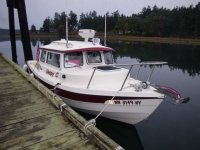Harvey, the reason it has 12.5 dB gain, is that it has an amplifier for the AIS in signal. What I don't know is what the SWRE and loss will be when you have the whole rig set up specifically on your boat, and that can only be determined when it is set up, and with some sophisticated equipment.
They recommend using their VHF/AIS antenna. AIS is 6 MHZ higher than the VHF signal--so on your VHF antenna there will be some miss match--the may or may not be made up by the amplifier in the AIS.
Remember when you are transmitting on VHF, you will not receive the AIS. When AIS is transmitting, you will not receive the VHF.
This splitter is better than the "simple" dumb splitter.
My choice would be the cheaper, and in many ways better, specific AIS antenna, and VHF antenna. There is no loss of signal of either device when there is transmission on the other. There is an antenna specifically tuned for the frequency which is being broadcast or received. There is going to be less loss. There is going to be better SWR with specific antennas. I have made this choice a number of times with my 2 meter ham radio gear (just below the VHF marine frequency, and the marine antenna will "work", but with some loss.
Your choice.

